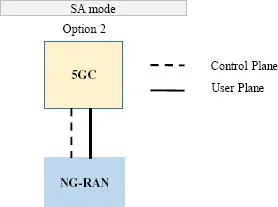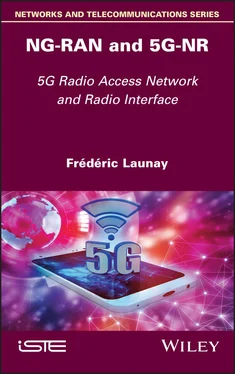Chapter 2presents the interfaces between the entities of NG-RAN radio access. It describes the protocol architecture on the Xn interface, the NG interface and the F1 interface, as well as the procedures for managing the interfaces of the NG-RAN network.
Similar to 4G CUPS (Control User Plane Separation) evolution, the 5GC network architecture separates the control plane to the user plane. The 5G-NSA and the 5G-SA architectures will be described by detailing interfaces and applications between the radio access entities and between the radio access and the network core (NG interfaces).
Chapter 3presents general procedures for 5G-NSA and 5G-SA modes. It describes the procedures on the radio access network concerning the cell search, the bearer establishment, the mobility management, the management of the secondary node, the beam management, as well as the procedures to the core network such as attachment and session establishment.
5G-NR spectrum allocation is more flexible compared to 4G LTE. In the time domain, frame flexibility is improved with the introduction of new numerologies. In the frequency domain, flexibility is achieved with bandwidth partitioning allocated to the terminals.
In order to avoid future development constraints, the management of the radio band is refined. Chapter 3describes the reference signals, physical signals, physical channels and their allocation on the 5G bandwidth.
5G improves the user’s throughput with active antenna technologies. Spatial multiplexing improvements are presented in both FR1 and FR2 bands. This chapter describes single- and multi-panel antennas, which require new measurements of the CSI radio channel.
To achieve 20 Gbps in the downlink direction and 10 Gbps in the uplink direction, the 5G-NR radio interface needs the following characteristics:
– the maximum radio channel bandwidth is 100 MHz for the FR1 band and 400 MHz for the FR2 band;
– carrier aggregation allows us to extend the channel bandwidth to 1 GHz;
– 256-QAM (Quadrature Amplitude Modulation);
– MIMO (Multiple Input Multiple Output) 8x8 transmission mode is used in downlink.
Chapter 4presents the 5G-NR physical layer. It describes uplink and downlink waveform formats, multiplexing modes, the 5G frequency bands and radio frames. Physical signals and physical channels on the uplink and downlink are detailed (uplink physical channels like PRACH, PUSCH, PUCCH and downlink like PBCH, PDSCH, PDCCH). The reference signals are also explained: CSI-RS, DM-RS, PT-RS, RIM-RS. Chapter 4also details the mapping of physical channels and physical signals on resource elements.
Chapter 5presents the physical layer mechanisms to improve throughput and coverage. It describes the SUL mode, the carrier aggregation mechanism, dual connectivity and spectrum sharing for 4G/5G coexistence.
Chapter 6presents MIMO mechanisms used to improve the robustness of the transmission (diversity), the bit rate (SU-MIMO, MU-MIMO) and the reduction of interference (beamforming). It describes the evolution of antenna capabilities from MIMO to massive-MIMO and single-panel or multi-panel transmission mechanisms. The procedure for managing the beams and improving data rate is described with the use of the code book for the uplink and downlink transmissions.
Chapter 7presents the partitioning of the 5G band. It describes initial band partitioning and BWP band switching, allowing the mobile to camp on a cell and, under the control of the base station, to adapt its radio capabilities to the traffic load. It also describes the search area and CORESET control resource elements.
Chapter 8introduces the data link layer. It describes the different SDAP, PDCP, RLC and MAC sublayers by presenting their functional role and the services between the different sublayers. For each of the sublayers, the structure of the protocol is detailed.
Chapter 9presents the messages sent by the RRC layer: broadcasting information, connection management, measurement configuration. It details the MIB and SIB messages, the procedures for establishing the radio link and the mobility of the mobile, as well as the elements to be measured.
A summary of the content of these nine chapters is provided in the following table.
| Chapter |
Designation |
Content |
| 1 |
NG-RAN network architecture |
Functional architecture NSA/SAIdentitiesUE contextgNB-CU/DUQoS and network slicing |
| 2 |
NG-RAN protocol architecture |
Protocol architectureeCPRI functional splittingInterface protocols (Xn, NG, F1)NG-AP and Xn procedure |
| 3 |
Radio access procedure |
Search cellAccess procedureData transmission procedureSession managementSecondary node establishmentBeam managementAttachment |
| 4 |
Physical layer of the 5G-NR interface |
Frequency bandMultiplexing structureReference signals: PSS, SSS, CSI-RS, PT-RS, RIM-RSPhysical signals: PSS, SSSPhysical channels: PBCH, PDCCH, PDSCH, PMCH, PUSCH, PUCCH, PRACH |
| 5 |
Operations on frequency bands |
Carrier aggregationSUL modeDual connectivity |
| 6 |
Multi-antenna structure |
SU-MIMOMU-MIMOBeamformingMassive-MIMOAntenna portChannel measurement reportsBeam management |
| 7 |
Bandwidth partition |
BWP initialCORESET#0BWP switching |
| 8 |
Data link layer |
SDAP protocolPDCP protocolRLC protocolMAC protocolStructure protocol |
| 9 |
RRC protocol |
NG-RAN procedureInformation systemsConnection controlMeasurementsBroadcasting control |
April 2021
1
NG-RAN Network – Functional Architecture
1.1. Functional architecture NSA/SA
Unlike previous generations of mobile networks, the deployment of 5G does not require the simultaneous implementation of the 5G core network (5GC) and the NG-RAN (Next-Generation Radio Access Network).
NSA (Non-Standalone Access) and SA (Standalone Access) are two 5G network models:
1 – SA is a completely new core service-based architecture: each radio node is autonomously controlled by the 5G core network. A service-based architecture delivers services as a set of NFs (Network Functions). NFs in the 5G core network are cloud native;
2 – NSA relies either on the 4G core network or on the 5G core network. NSA anchors the control signaling to the core network through a radio MN (Master Node). The MN is either a 4G radio node or a 5G radio node. The MN controls an SN (Secondary Node) (4G radio node or 5G radio node) according to the DC (Dual Connectivity) mechanism.
The 5G-SA architecture requires the deployment of a 5G core network connected to the NG-RAN.
The 5G-NSA architecture and the 5G-SA architecture were introduced in Release 15 of the 3GPP standard.
The 5G-NSA configuration implements the MR-DC ( Multi Radio Dual Connectivity ) architecture.

Figure 1.1. Deployment in the SA mode
Dual connectivity involves two RAN nodes, i.e. master node (MN) and secondary nodes (SN) which has the following features:
1 – the MN is connected to the core network for the control plan (signaling) and for the user plane;
2 – the SN is controlled by the MN. It is connected to the MN for the control plane (C-plane). The user plane (U-plane) is either connected to the MN or connected to the core network;
3 – the master radio access node controls the secondary radio access node and establishes a bearer, if necessary, for the exchange of data between the two radio nodes.
Читать дальше













